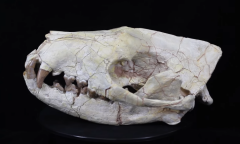By Jenia Cane, | May 08, 2017

Ancient Egypt Funerary Garden
An ancient rectangular funerary garden planted with lettuce, shrubs and trees once stood in ancient Egypt about 4,000 years ago.
According to archaeologists from the Spanish National Research Council (CSIC), the botanical-cum-funeral garden was discovered along the Dra Abu el-Naga hill in Luxor.
Like Us on Facebook
With this major archeological find, researchers expect to learn more about the inhabitants of what was once ancient Thebes.
Based on the scientists' findings, Thebes was considered the capital of Upper and Lower Egypt during the garden's construction.
But what made the discovery of the ancient funerary garden special was that it was the first one discovered in Egypt although the archeologists' knew they existed because their illistrations were inscribed in tombs.
"We knew of the possible existence of these gardens since they appear in illustrations both at the entrances to tombs, as well as on tomb walls, where Egyptians would depict how they wanted their funerals to be," José Manuel Galán, the CSIC archaeologist who led excavation, known as the Djehuty Project, explained in a statement.
Galán revealed the rectangular garden was elevated about 1.6 feet (0.5 meters) off the ground and sub-divided into beds, with each having a size of about 0.03 square feet (30 square centimeters).
He added that two trees were planted next to the garden.
"This is the first time that a physical garden has ever been found, and it is therefore the first time that archaeology can confirm what had been deduced from iconography," pointed out.
Galán disclosed that studying the ancient funerary garden helped them understand the kind of plants that thrived and the prevailing environmental conditions during that particular period in ancient Thebes, Egypt.
It is worth noting that the garden's discovery came during the 16th year of archaeological excavations which funded this year by Técnicas Reunidas and Indra.
"The plants grown there would have had a symbolic meaning and may have played a role in funerary rituals," Galán said.
"Therefore, the garden will also provide information about religious beliefs and practices as well as the culture and society at the time of the Twelfth Dynasty when Thebes became the capital of the unified kingdom of Upper and Lower Egypt for the first time," he added.
Also attached to the facade of the ancient funerary garden in Egypt is a small mud-brick chapel (46cm high x 70cm wide x 55cm deep) with three stelae, or stone tombstones, whose interior was also uncovered.
-
Use of Coronavirus Pandemic Drones Raises Privacy Concerns: Drones Spread Fear, Local Officials Say

-
Coronavirus Hampers The Delivery Of Lockheed Martin F-35 Stealth Fighters For 2020

-
Instagram Speeds Up Plans to Add Account Memorialization Feature Due to COVID-19 Deaths

-
NASA: Perseverance Plans to Bring 'Mars Rock' to Earth in 2031

-
600 Dead And 3,000 In The Hospital as Iranians Believed Drinking High-Concentrations of Alcohol Can Cure The Coronavirus

-
600 Dead And 3,000 In The Hospital as Iranians Believed Drinking High-Concentrations of Alcohol Can Cure The Coronavirus

-
COVID-19: Doctors, Nurses Use Virtual Reality to Learn New Skills in Treating Coronavirus Patients









